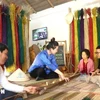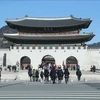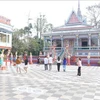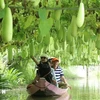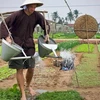The northwestern mountainous province of Dien Bien will expand the model of building cultural hamlets to develop its tourism following a successful pilot in a Thai ethnic hamlet, according to radio The Voice of Vietnam (VOV).
Together with 20 other hamlets across Vietnam, Che Can hamlet in Dien Bien district was selected in 2009 for a project to preserve Vietnam’s traditional cultures.
Che Can was given 450,000 USD to restore the local Thai people’s traditional houses, festivals, musical instruments, and brocade weaving.
"Thanks to an investment in 2010 from Dien Bien district's Division of Culture to develop brocade and rattan weaving, we have set up weaving groups with up to six people and an artisan in each group," head of Che Can hamlet Ca Van Oi told VOV.
Brocade weaving classes have been organised every year, he said, adding that the products are displayed in traditional houses as souvenir.
Members of the weaving groups in Che Can are now skilled enough that they are able to complete complicated brocade products such as Pieu scarves, bags, blankets, and mattress covers.
Women in the hamet now often practice brocade weaving when farm work slows and have become more aware of the importance of preserving their traditional craft of brocade weaving.
Villager Lo Thi Chung said: "Our craft would have fallen into oblivion without this effort and our children would have no memory of it someday. We have done a lot to promote the weaving craft by introducing it to both local people and visitors. This trade has raised our incomes and helps us pay for our children’s education."
The model of developing cultural hamlets for tourism has proved to be a good solution for new rural development in Muong Phang commune, too.
Secretary of the Muong Phang Party Committee Lo Van Bien said: “We are trying to develop the local economy by growing fruit trees, developing the craft of brocade weaving, and creating our own tourist products for visitors. For example, we’ve organised cultural exchanges to introduce our history and our unique cultural identity to visitors through brocade weaving and the local cuisine."
Dien Bien province has applied this model in eight other hamlets, in which art troupes have been established to entertain visitors, promote the local culture and arts, and generate more income for local residents. The hamlets are being helped to develop the model of community-based tourism.
To attract more visitors, local people have altered their habits to preserve a green, clean environment.
Lo Van Un, chief of Ten hamlet in Dien Bien district, said that they understand the goal of building a cultural hamlet and are now more aware of preserving their unique culture and actively participating in local cultural and art movements. Local authorities have paid a lot of attention to persuading people to maintain a green, clean environment and encouraging them to donate land for new roads.
Dien Bien province has approved a project to build cultural hamlets to develop provincial tourism by 2015.
In addition to the eight Thai hamlets, 10 hamlets of the H'Mong, Kho Mu and Ha Nhi minority people will also receive funds to develop this new model of cultural tourism.
Home to 21 ethnic minority group, Dien Bien province has long been a popular tourist destination with many historical places closely associated with the 1954 Dien Bien Phu victory.-VNA
Together with 20 other hamlets across Vietnam, Che Can hamlet in Dien Bien district was selected in 2009 for a project to preserve Vietnam’s traditional cultures.
Che Can was given 450,000 USD to restore the local Thai people’s traditional houses, festivals, musical instruments, and brocade weaving.
"Thanks to an investment in 2010 from Dien Bien district's Division of Culture to develop brocade and rattan weaving, we have set up weaving groups with up to six people and an artisan in each group," head of Che Can hamlet Ca Van Oi told VOV.
Brocade weaving classes have been organised every year, he said, adding that the products are displayed in traditional houses as souvenir.
Members of the weaving groups in Che Can are now skilled enough that they are able to complete complicated brocade products such as Pieu scarves, bags, blankets, and mattress covers.
Women in the hamet now often practice brocade weaving when farm work slows and have become more aware of the importance of preserving their traditional craft of brocade weaving.
Villager Lo Thi Chung said: "Our craft would have fallen into oblivion without this effort and our children would have no memory of it someday. We have done a lot to promote the weaving craft by introducing it to both local people and visitors. This trade has raised our incomes and helps us pay for our children’s education."
The model of developing cultural hamlets for tourism has proved to be a good solution for new rural development in Muong Phang commune, too.
Secretary of the Muong Phang Party Committee Lo Van Bien said: “We are trying to develop the local economy by growing fruit trees, developing the craft of brocade weaving, and creating our own tourist products for visitors. For example, we’ve organised cultural exchanges to introduce our history and our unique cultural identity to visitors through brocade weaving and the local cuisine."
Dien Bien province has applied this model in eight other hamlets, in which art troupes have been established to entertain visitors, promote the local culture and arts, and generate more income for local residents. The hamlets are being helped to develop the model of community-based tourism.
To attract more visitors, local people have altered their habits to preserve a green, clean environment.
Lo Van Un, chief of Ten hamlet in Dien Bien district, said that they understand the goal of building a cultural hamlet and are now more aware of preserving their unique culture and actively participating in local cultural and art movements. Local authorities have paid a lot of attention to persuading people to maintain a green, clean environment and encouraging them to donate land for new roads.
Dien Bien province has approved a project to build cultural hamlets to develop provincial tourism by 2015.
In addition to the eight Thai hamlets, 10 hamlets of the H'Mong, Kho Mu and Ha Nhi minority people will also receive funds to develop this new model of cultural tourism.
Home to 21 ethnic minority group, Dien Bien province has long been a popular tourist destination with many historical places closely associated with the 1954 Dien Bien Phu victory.-VNA

